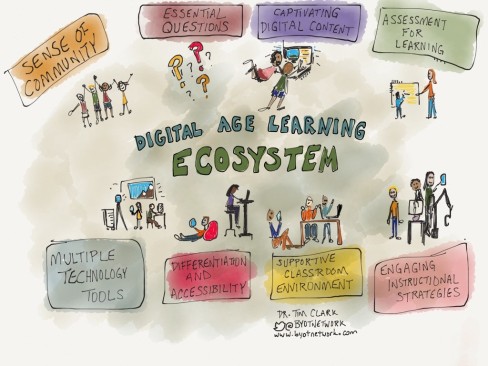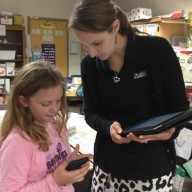Question: As a 3rd grade teacher, how can I demonstrate knowledge, skills, and work processes that represent an innovative education in a global and digital society?
ISTE Standard 3: Model digital-age work and learning.
“Digital-Age Learning describes the shift from traditional teacher-directed instruction to student-centered learning with the use of technology skills.” Dr. Tim Clark, 2013.
Dr. Tim Clark, a promoter of the practice “Bring Your Own Technology” (BYOT), believes that there are many benefits of BYOT in the educational setting—beliefs that are rooted in the theories of Lev Vygotsky, as well as the belief that learning is fundamentally social. In a world where digital technologies are ever growing and changing, Clark explains how children will develop cognitively when they are using the “tools of their culture” for “learning purposes as they collaborate and interact with their teachers and each other to research information, solve complex problems, create original products, and publish their work to show what they have learned” (Clark).

Dr. Tim Clark’s Eight Components of the Digital Age Learning Ecosystem (Source: https://byotnetwork.com/tag/digital-age-learning/ )
The eight components of a digital age learning environment include: community, essential questions, captivating digital content, assessments for learning, multiple technology tools, differentiation and accessibility, supportive classroom environment, and engaging instructional strategies (see Figure 1). This means that students and teachers are all working and learning together in an environment that allows for the exploration of open-ended questions that provoke deeper thinking and promote inquiry. Teachers are modeling for students strategies for research that give access to rich multi-media content, in an environment where learning experiences are tailored to the different needs and approaches to learning that each student brings to the classroom. The classroom environment—both physical and digital—allows for a variety of spaces for individual work as well as collaborative work and discussion, and the learning of students is assessed with risk-free formative assessments. Students are allowed to bring their own technology tools, which allows for opportunities to learn when and how to use the right tool for a digital job, as well as chances for students and teachers to learn from each other.

Teachers and students can learn from each other on various technology tools. Source: BYOT Network https://byotnetwork.com/tag/digital-age-learning/
Finally, the instructional strategies used by the teacher are well-thought out and planned so that they engage learners and give a focus on communication skills, collaboration, creativity, and critical thinking. It is important that teacher understand that they can facilitate student learning without everyone doing the same thing, at the same time, and in the same way.
Maintaining a digital age learning environment needs some guidelines, so that teachers don’t fall back to rote instruction such as lectures and recalling information. In order to do this, explains Dr. Clark, you must: build the learning community with clear, consistent expectations related to an atmosphere of safety and respect; utilize student expertise by allowing students and teachers to learn to rely on each other for technology assistance (a practice which helps “empower students to discover new skills for life-long learning” (Clark, 2013); focus on digital age skills of communication, collaboration, creativity, and critical thinking; provide continuous professional learning where teachers are able to observe and rely on each other for new strategies and implementation; and encourage the regular use of technology so that learners and teachers can discover new uses for technology tools that make learning a normal and enjoyable process. This idea reminds me of a question asked by classmate Jenessa, who asked, “Is there a place to be explicitly teaching to using technology as a means to an end rather than teaching through it to access and integrate it with other subjects? I mean, do you think teaching elementary students technology as sort of a stand-alone lesson (as opposed to using it to teach literacy) practical or warranted?” To answer to this question: Teaching technology as a stand-alone lesson is not practical in this digital age. We should be implementing it into everything, so that it doesn’t become such a production and hassle when it is used. This idea stands out to me the most, because sometimes including technology in my own day-to-day lessons can be a daunting and challenging task.
Implementing and starting a digital and technology-immersed program can be difficult. I struggle with it in my own classroom—a classroom that is part of a Microsoft Innovative School. Getting my third-grade students to get their Surface Pro tablets out and open can be a production sometimes. One way that I could integrate digital technology more into the classroom, so as to avoid such a production and make the learning with technology more of a regular thing, is through literacy instruction. Authors Amy Hutchinson and Lindsay Woodward seem to support the work of Dr. Clark and stress the importance of remembering that, as educators, we want our students to be prepared for the future in the age of digital technologies, so it is imperative that students understand digital modes of reading and writing. This is especially important when we consider that screens have essentially replaced books. Additionally, Common Core Standards that are relevant in most schools today require the use of digital tools with learning. When I consider the integration of technology into my literacy lessons (or any lesson), I need to consider the usefulness of the digital tools, as well as the TPACK model to be sure I am drawing on content and pedagogy knowledge with technology knowledge in order to create meaningful lessons with my students. Most importantly, however, I need to remember that in just a few years, books and other instructional materials may be obsolete. It is my job as an educator to prepare my students for the digital world of work and learning by implementing technology tools into my daily instruction and classroom environment.
References:
Clark, T. (2013, Dec. 9). BYOT Network Blog: Sustainable Practices for Digital Age Learning. Retrieved from: https://byotnetwork.com/2013/12/09/sustainable-practices-for-digital-age-learning/
Clark, T. (2014, July 6). BYOT Network Blog: The Components of a Digital Age Learning Ecosystem. Retrieved from: https://byotnetwork.com/2014/07/06/the-components-of-a-digital-age-learning-ecosystem/
Hutchinson, A. & Woodward, L. (2014). A Planning Guide for Integrating Digital Technology into Literacy Instruction. Reading Teacher, 67(6), 455-464. Doi: 10.1002/trtr.1225. Retrieved from: http://ezproxy.spu.edu/login?url=http://search.ebscohost.com/login.aspx?direct=true&AuthType=ip&db=aph&AN=94728765&site=ehost-live (Links to an external site.)

Bravo! I agree with your points on how technology is not only reshaping our instruction but also the dynamics of classroom environment as well. Granted while it is ideal for technology to be infused and so fully integrated, there must be routines and procedures that better support and facilitate both technological access and production. Thank you for your challenging thoughts!
LikeLike